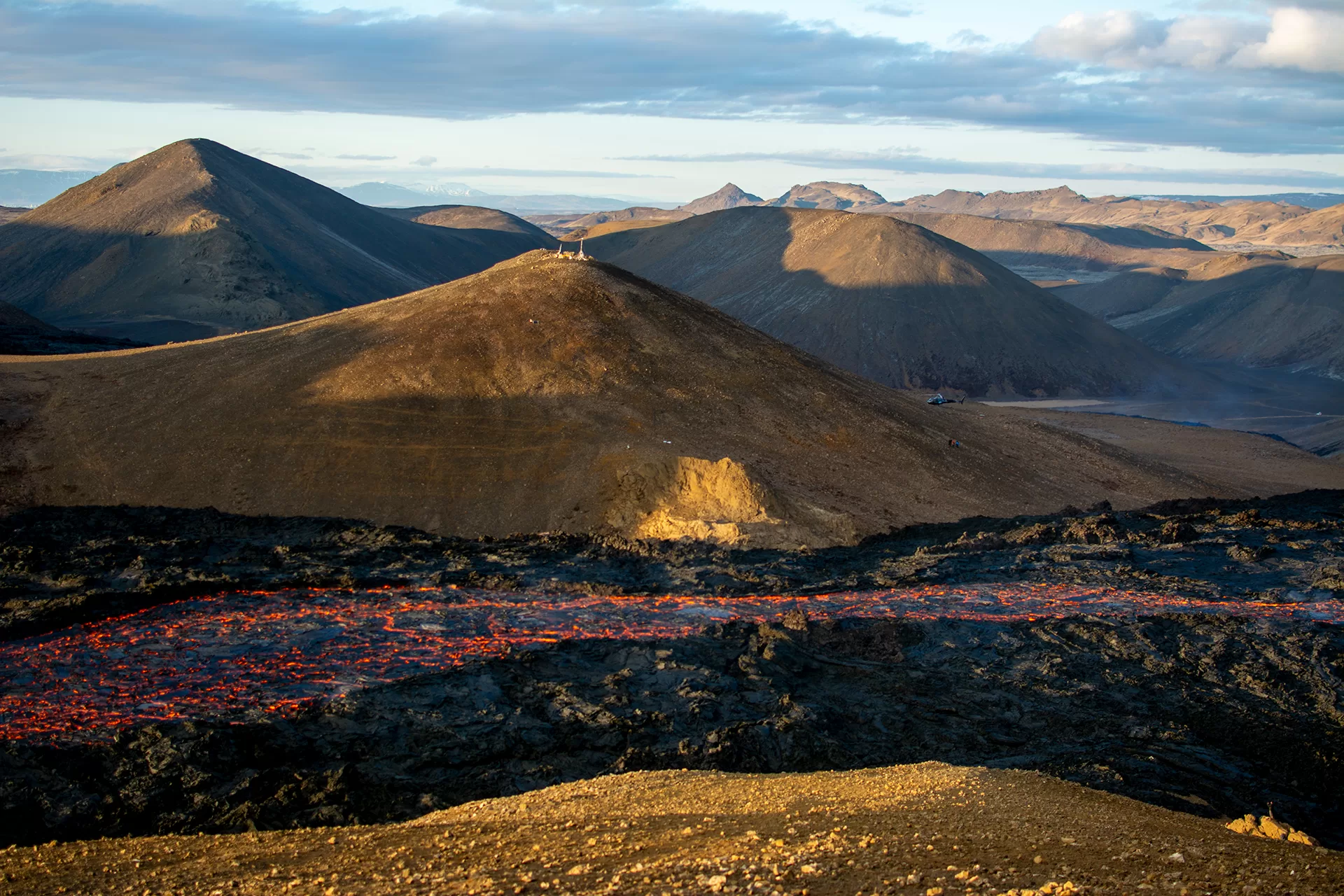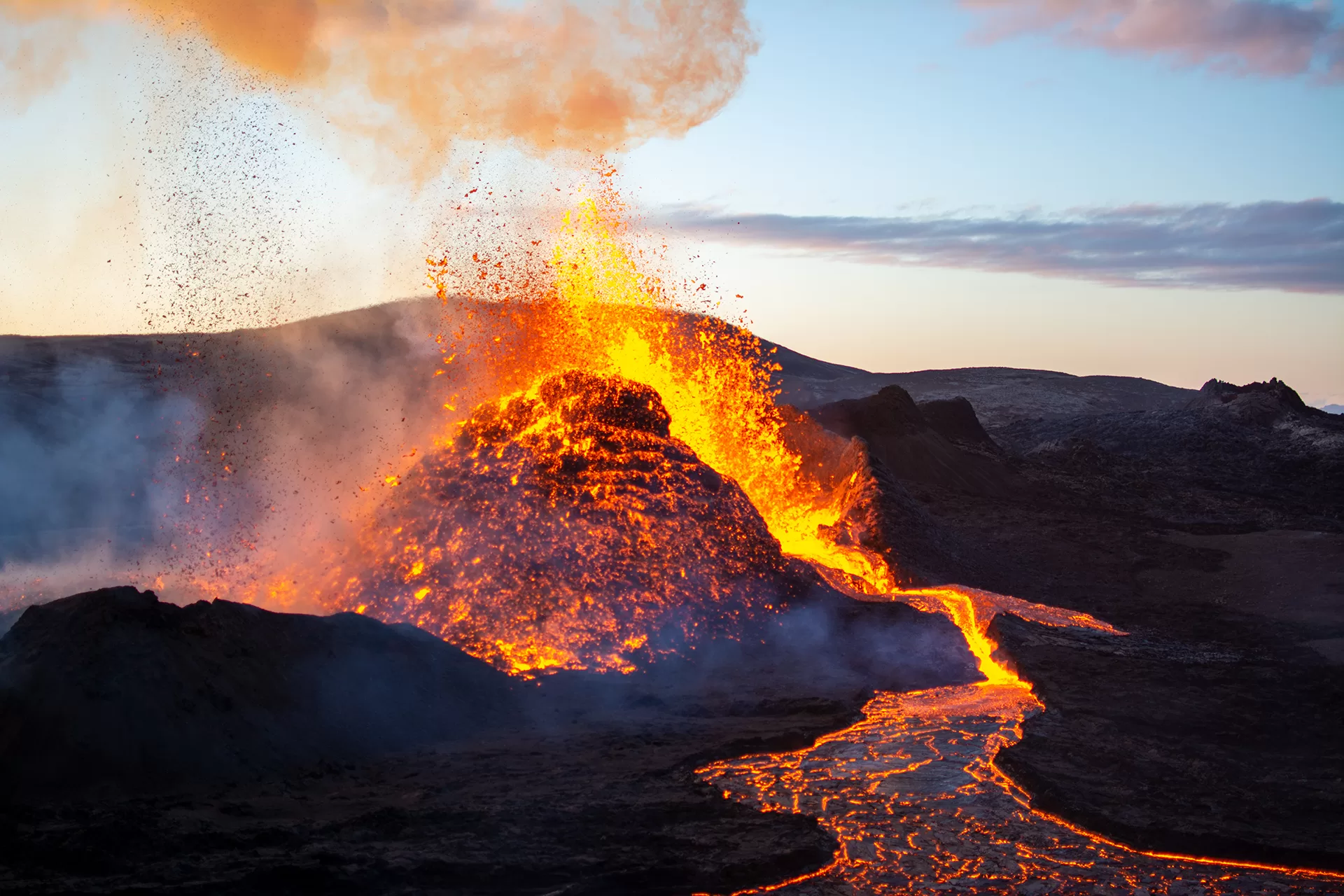
The baptism of fire
Volcanoes showcase our planet’s majestic energy. Silent or steaming, their explosions act on humans like a “thrill of a fly suspended over a pot of bubbling milk"
by Leonardo Piccione
Photos by Matt Wisniewski. In this picture the Fagradalsfjall volcano cools down after putting on a show for eager onlookers.
Ever since he discovered Iceland on an atlas as a child, Leonardo has been drawn to the remote island. He now spends six months of every year there. The restlessness of the island’s nature, its constant movement, and inherent instability reflect Leonardo’s reluctance to make long-term plans or settle into a stable living situation. For Leonardo, the island’s volcanoes symbolize this strange relationship. He has found a unique balance in the chaos of Iceland, the land of the unfinished.

Fire and Ice — On March 19, 2021, the Icelandic valleys of Geldingadalir saw their usual stillness interrupted by the Fagradalsfjall volcano, when an eruptive fissure opened to the disruptive power of lava undercurrents. After several previous warnings — in the form of earthquakes — the eruption eventually arrived in the evening. And, despite being one of Earth’s most frightening manifestations of power, the event actually attracted tourists from all over the country, eager to witness the otherwise spectacular show of nature. In this picture a river of lava bathes the Geldingadalir valleys surrounding the volcano.
Little by little, I managed to unsubscribe from almost every mailing list I had joined more or less voluntarily over the years. There were so many that it was overwhelming. I said goodbye to breaking news from the world’s leading news agency, weekly updates from my favorite sports magazine, unrelenting instant deals from low-cost airlines, and seasonal sales announcements from my favorite Japanese brand.
I still get messages from a Finnish newspaper that I once browsed for some obscure reason. Their emails don’t seem to have an unsubscribe button, so they keep trying to (hopelessly) win me back as a subscriber. But I don’t mind continuing to receive emails from the Lava Centre in Hvolsvöllur. These four words may mean nothing to you, but the Lava Centre is important in my life.
The Lava Centre in Hvolsvöllur is a volcanological museum in southern Iceland that, in addition to its nontrivial mission of being a museum, has undertaken another important task: to inform its followers in detail about ongoing seismic activity in Iceland. Specifically, it sends an email whenever the island’s seismographs detect an event of magnitude greater than 3. Day and night, summer and winter, rain or shine, the Lava Centre in Hvolsvöllur tirelessly informs you of the progress of the evil scheme of the earth you insist on treading, as it opens a gap beneath your feet to ultimately swallow you up.
More than five years after moving to Iceland, I can say beyond a shadow of a doubt that the notifications from the Lava Centre in Hvolsvöllur are — alongside the constant updates of the National Meteorological Institute’s weather forecasts — one of the most distinctive aspects of my time spent on the brink of the Arctic Circle. In short, my life in Iceland is a constant back-and-forth between snowstorm alerts and notifications of developing earthquake swarms. But rather than increasing my anxiety, I find this sense of impending catastrophe fascinating and even irresistible. There’s something magnetic and irrational about it that I can’t quite explain. This feeling of existential uncertainty simply makes me feel good. I’m thrilled when the vedur.is website predicts snowfall so heavy that it may cover my windows, and I’m captivated when the Lava Centre in Hvolsvöllur reminds me that Iceland is still frighteningly restless.

Photos by Matt Wisniewski — In this picture lava fireworks gush out of Fagradalsfjall at the start of a long arctic sunset.
To be quite clear: I’m not generally a big fan of doom and gloom, nor do I want to star in any disaster movie. But there’s something about the sound of arctic seismographs ringing above the din of my inbox that I find appealing. I think it’s because I hope those enigmatic warnings lead to a much greater consequence of Iceland’s unyielding vitality, the root motivator that brought me up here and retains me: the eruption of a volcano.
I vividly remember the excitement I felt on the evening of 19 March 2021. After weeks of tremors and volcanological surveys — not to mention a flood of emails from the Lava Centre in Hvolsvöllur — the Icelandic authorities reported that an eruptive fissure had opened up near Mount Fagradalsfjall. The earthquakes of the previous months had been caused by magma intrusions that finally broke through the earth’s crust and surfaced in a valley on the Reykjanes peninsula. It was the first time in over eight centuries that lava had flowed down those slopes. Nine days later, I joined hundreds of other hikers who had traveled to the southwest to witness the most photographed eruption in Iceland’s history — and the first one I had ever seen.
Although most of my fellow explorers were there just to turn the daring trek into lots of likes on Instagram, and a team of civil defense workers was carefully monitoring the eruption site, I still felt an incredible emotional rush that afternoon. Despite the thrills of danger and recklessness being subdued by their presence, being close to the largest bonfire I had ever seen was an unforgettable experience. It was a mix of longing and fear, like the thrill of a “fly in a saucepan of milk that’s boiling over,” as once described by Katia Krafft — a renowned volcanologist and the protagonist, along with her husband Maurice, of the masterful documentary Fire of Love.
Perhaps there’s a more complex inner reason behind the “call of the volcano” than just a basic survival instinct, whether that is comforting or not.
In the months since my baptism of fire, scrolling through the photos from 28 March two years ago, I have often wondered about the dual nature of that attraction and the double-faced smile smeared on my cheeks numbed by basaltic fumes. Why did I, lacking the majesty of Katia Krafft’s geological ambition, feel the same way she did when standing before an eruption? How was it that I, not being particularly brave, had to push back the inconceivable urge to dip my hands into the red-hot stream of lava flowing beside me? Ultimately, what was it that gave me this subtle, irrepressible lust for danger, the unfathomable pleasure “of approaching the beast, not knowing if it will catch you,” once again in the words of Katia Krafft?
I think my unexpected bravery — and, more in general, my decision to live in Iceland — can be explained by a youthful desire to defy common sense and push my limits. It’s the thrill of being able to say “I did it again; I’m still here; I survived.” This basic instinct is one reason humans have survived on an island that Bergsveinn Birgisson called “habitatus inabitabile” in one of his novels. But to me, this explanation seems too simple.
Perhaps there’s a more complex inner reason behind the “call of the volcano” than just a basic survival instinct, whether that is comforting or not. I think our appreciation of beauty in the violent explosion of molten rock has something to do with aging and disillusionment due to experience. It’s a form of maturing and hardening of the heart. The less trust we have in humankind, the more we turn to nature and find truth in the actions of a volcano, as it acts without scheming or hidden motives — destruction for destruction’s sake, creation for creation’s sake. It’s pure necessity. Waiting for an eruption becomes a form of liberation from the complex structures that make us believe we are distinct from Nature.
I’m still subscribed to the Lava Centre in Hvolsvöllur’s mailing list for all these reasons. Lately, I’ve been receiving more and more emails about increased activity around Herðubreið, a flat-topped mountain known as “the queen of the Icelandic mountains.” If it were to erupt, its iconic shape — which is even printed on licorice wrappers here — would be changed forever or even destroyed. It would be awesome.